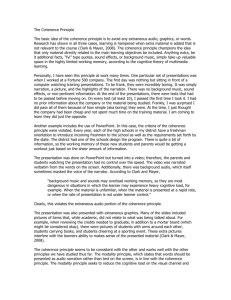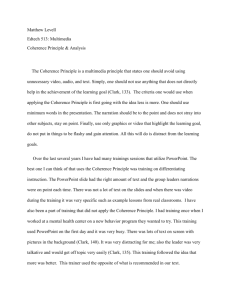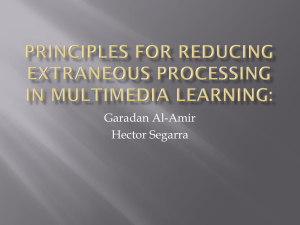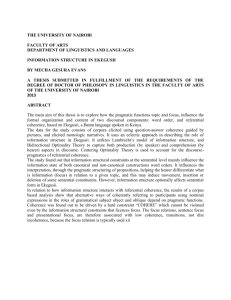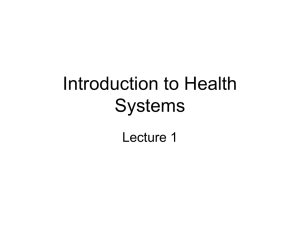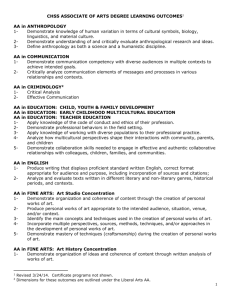Coherence Principle
advertisement
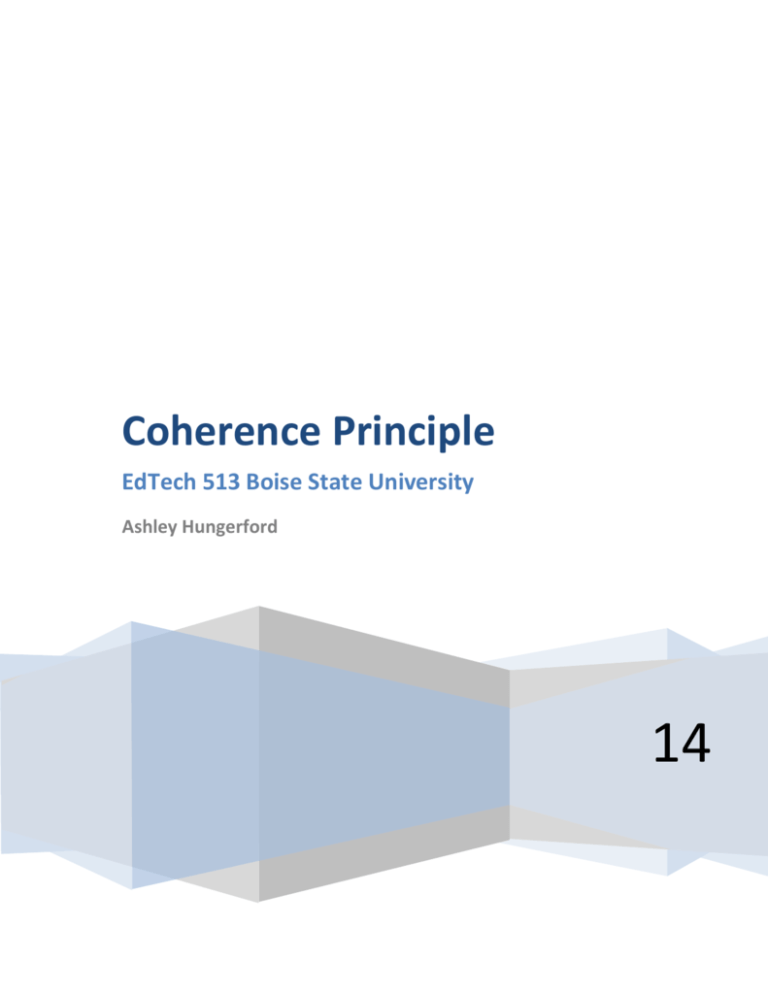
Coherence Principle EdTech 513 Boise State University Ashley Hungerford 14 COHERENCE PRINCIPLE 2 The coherence principle, in its most basic form, states that in regards to e-learning students retain and transfer information better when unnecessary material is left out of the learning module. Clark and Mayer carefully lay out what is considered to be unnecessary or extraneous material; but they also note that one must not apply any principle to every situation without thought to its relevance and the needs of the specific learner (Clark & Mayer, 2011). Materials deemed to be extraneous according to the coherence principle are as follows: 1. Extraneous audio- unnecessary music, sound effects, and voice-over 2. Extraneous graphic- images, videos, cartoons etc… 3. Use of simpler visuals- unnecessarily advanced or detailed images 4. Extraneous words- those added for interest, to expand on ideas, or technical depth (Clark & Mayer, 2011) Upon reading about the coherence principle I suddenly became aware of how often I have unintentionally broken this principle. I most often break this principle with regards to extraneous graphics and occasionally extraneous words. I decided to go back and review my past presentations to determine how often I break the rules of coherence and I discovered that my record is not as bad as I initially thought it might be. Within the past month I have used several presentations that were created by another IB Biology teacher and I have chosen to provide examples from two of them to show presentations that follow coherence principles and those that do not. COHERENCE PRINCIPLE 3 The pictures above are examples of slides from a presentation that does not follow the coherence principle. The picture on the left has an extraneous image that serves no real purpose in educating the viewer on ecology. According to Clark and Mayer (2011), extraneous images are a distraction “by guiding the learner’s limited attention away from the relevant material and toward irrelevant material” (p. 161). The image on the right violates numerous principles as it has extraneous word and it is redundant. In this incidence the images on the right are enough to explain the process without all of the repetitive text on the left. The use of the extraneous text not only overloads the channels but is also redundant. Clark and Mayer (2011) state that “rather than fully embellished textual or narrative descriptions stick to basic and concise descriptions of the content” (p. 166). The two slide images above are examples of presentation slides that follow coherence principles. The slides do not possess any music or sound, they do not have unnecessary images or words and as a result COHERENCE PRINCIPLE 4 they do not block the learning channels. The image on the left is simple but the message is much more complex. With the use of words, colors and placement the slide communicates a concept in only 8 words. The image on the right has only essential textual information, and possesses several images, all of which are relevant to completing the task and understanding the presentation. Both of these slides represent the spirit of the coherence principle, they do not contain unnecessary data, graphics, or sound and they communicate the idea simply. The coherence principle seeks to accomplish the same objective as every other principle we have studied thus far; to help the learner receive, process, and transfer information in the most efficient and effective way. The multimedia principle is about helping the learner better process information through the use of graphics and written word. “A fundamental premise underlying the use of multimedia is that learners understand explanations better when they receive words and corresponding pictures rather than words alone” (Mayer, 1999, p. 617).The contiguity principle attempts to aid the learner in receiving and processing information through visual and textual placement. “The rationale is that students need to be able to easily find corresponding visual and verbal information with a minimum of visual search” (Mayer, 1999, p. 617). The modality principle suggests that replacing textual information with auditory narration makes receiving and processing information through the learning channels more effective; this principle is in direct alignment with the coherence principle which also seeks to minimize clutter along the learning channels. The redundancy principle states that one should not attempt to present information in both text and audio formats as it is redundant and extraneous. The redundancy principle also directly aligns with the coherence principle as it seeks to eliminate extraneous use of information in order to free up the learning channels for essential information. The coherence principle was founded upon principles of psychology. One psychological principle that the coherence principle addresses is the arousal theory, which states that people will be more COHERENCE PRINCIPLE 5 productive if they are emotionally aroused or invested in the material. This seems to make sense, and I believe that in some instances drawing on people’s emotions can be a useful tool, especially in sales and media; but the coherence principle chooses the theoretical rationale of the cognitive theory of multimedia learning instead. According to an article by Moreno and Mayer, “our cognitive theory of multimedia learning draws on dual coding theory, cognitive load theory, and constructivist learning theory” (Moreno & Mayer, 2000). The cognitive theory of multimedia “predicts that students will learn more deeply from multimedia presentations that do not contain interesting but extraneous sounds and music than from multimedia presentations that do” (Clark & Mayer, 2011, p. 156). When considering whether to utilize the cognitive theory over the arousal theory it must be noted that the arousal theory has one major flaw, that flaw comes from the premise that making someone more interested in a presentation does not actually increase their interest level in the subject matter (Clark & Mayer, 2011, p. 161). Adding extraneous graphics, words, or sound for the sake of interest has not been proven to be effective, as a matter of fact, many people, including Clark and Mayer, suggest that extraneous material can actually impede the learning process (Clark & Mayer, 2011, p. 168). Clark and Mayer (2011) provided research in previous chapters on overloading the audio and visual channels, which bottlenecks the information and prevents the flow of new information to the brain. Extraneous information in any form can cause this bottlenecking affect which can impeded learning (p. 154). The coherence principle seeks to minimize the amount of extraneous information flowing through the channels at one time, allowing information to be more easily absorbed, processed, and transferred. I personally believe that for the majority of situations the coherence principle applies to elearning. I am not sure that the coherence principle applies to presentations that take place in person, at least not with regards to making a presentation more interesting. Most of the presentations that I have been a part of, as a learner, were monotonous, the ones that are memorable were the ones that made things more interesting. I remember almost everything I learned from one of my in-service trainings on COHERENCE PRINCIPLE 6 the brain because the presenter began with a video, that while related to the topic in general served more as an arousal technique than actual fact. From that point he hooked me, I wanted to know more and learn more; he used comedy and brought in current events to make the presentation more relevant. I ask myself would I have learned as much with a more simplified presentation, without the bells and whistles, and I have to say that I do not believe I would have been intrinsically motivated enough to devote the time to processing the information. The presenter motivated me, he hooked me in the first few minutes and kept me on the line long enough to disperse the relevant information and reel me in. Given the parameters of e-learning I would say that the coherence principle likely applies more readily. As a science teacher I felt strongly that the research experiments conducted were good evidence of the validity of the coherence principle. I would like for the authors to have addressed more thoroughly the differences between e-learning and in person classes. I feel as though the case studies addressed situations that would apply to both in person and e-learning but the specifics for the differences were not mentioned. It seems as though the argument could have been made stronger if the issue of motivation to learn material were covered in more depth. Clark and Mayer mention in the psychological aspect sections the arousal theory, but almost dismiss it as being of little or no importance in e-learning as it doesn’t actually promote interest in the subject. I think I would have to disagree on this point, I believe that one does not always know going into a presentation what their level of interest in the topic would be; sometimes an external motivation that causes them to feel connected to an issue can bring about interest in a subject. As an example, I took an online class in anthropology it wasn’t my first choice but it was the only online course available that met my requirements. The first day of class the professor required us to attend a Google hangout. In our first Google hangout the professor showed us a heart wrenching video about anthropologists taking part in a study on genocide, the professor hooked me in that first class because he forced me to care, to take an active interest. I later learned that we never addressed that specific case in anthropology again, but it opened me up to learning about COHERENCE PRINCIPLE something that wasn’t on my radar before. When a student is engaged in learning I believe it can open doors to learning. I understand and mostly agree with the coherence principle, but I believe that the instructor must also attempt to arouse a student's interest, and apply whatever means necessary to instruct and engage his or her students. Works Cited Clark, R., & Mayer, R. E. (2011). E-Learning and the Science of Instruction (third edition ed.). San Francisco: Pfeiffer. Mayer, R. (1999). Multimedia aids to problem-solving transfer. International Journal of Educational Research, 611-623. Moreno, R., & Mayer, R. E. (2000, February 5). A Learner-Centered Approach to Multimedia Explanations: Deriving Instructional Design Principles from Cognitive Theory. Retrieved from Interactive MultimediaElectronic Journal of Computer Enhanced Learning: http://imej.wfu.edu/articles/2000/2/05/index.asp 7
